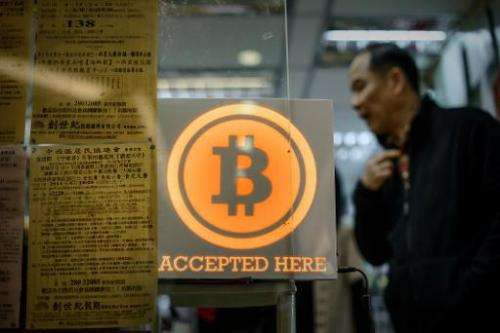Man identified as Bitcoin creator denies involvement

A man walks past the reported home of “Satoshi Nakamoto” in Temple City, east of Los Angeles, California on March 6, 2014
A man named as being the enigmatic creator of Bitcoin on Thursday denied having a role in the virtual currency, telling reporters he was not involved.
In an exclusive report, Newsweek identified a 64-year-old Japanese-American physicist as being the mysterious person known as “Satoshi Nakamoto” behind the Bitcoin revolution.
However the man, who told the Associated Press news agency his name is Dorian Prentice Satoshi Nakamoto, told reporters outside his modest two-story house in suburban Los Angeles: “I’m not involved in Bitcoin.”
Since its 2009 launch, the Bitcoin phenomenon has been hailed as a financial revolution, despite scandals over its use in drug trafficking and money laundering.
Nakamoto, who was pursued by a media pack as he drove off for an interview at the AP’s offices, told the agency that the first time he heard of Bitcoin was when his son told him he had been contacted by a Newsweek reporter three weeks ago.
He said he phoned police when the magazine’s reporter knocked on his door.
While acknowledging that some of the biographical details in the Newsweek report were true, Nakamoto denied its claim that he was “the face behind Bitcoin.”
But Newsweek stood by its story, saying his career involved classified work as a systems engineer for the US government and that he initially tacitly acknowledged his role in creating the crypto-currency that has rocked the banking world.
Language barrier
Nakamoto, who is not a native English speaker, said a key element of the Newsweek story—in which he is quoted as telling the reporter on his doorstep “I am no longer involved in that, and I cannot discuss it”—was misunderstood.
“It sounded like I was involved before with Bitcoin and looked like I’m not involved now. That’s not what I meant. I want to clarify that,” he told the AP.
“I’m saying I’m no longer in engineering. That’s it,” he said of the exchange with the Newsweek reporter.
“And even if I was, when we get hired, you have to sign this document, contract saying you will not reveal anything we divulge during and after employment. So that’s what I implied.”
A throng of reporters stood outside the AP bureau during Nakamoto’s interview, hoping to catch a glimpse of him. But building security told the group of about 20 journalists to leave and wait outside in the parking lot.

A man walks out of a shop displaying a bitcoin sign during the opening ceremony of the first bitcoin retail shop in Hong Kong on February 28, 2014
The Bitcoin Foundation, which supports the development of the currency, would not confirm Newsweek’s story.
“We have seen zero conclusive evidence that the identified person is the designer of Bitcoin. Those closest to the Bitcoin project, the informal team of core developers, have always been unaware of Nakamoto’s true identity, as Nakamoto communicated purely through electronic means,” it said.
Newsweek, however, laid out a strong story, in a scoop meant to relaunch its first print issue after publishing online for two years.
It said Nakamoto was born in Japan in 1949 and emigrated to the United States when he was 10.
He studied physics at California State Polytechnic University and worked for a number of companies, but has apparently not held a steady job since 2002.
He spends much of his time on his model train hobby and has apparently not tapped into the millions of dollars of Bitcoin wealth Newsweek says comes from authoring the computer code behind it.
A libertarian streak
His family, including two younger brothers who are also scientists, said they had no knowledge of his alleged link to Bitcoin.
“He’s a brilliant man,” his brother Arthur Nakamoto told Newsweek. “He’s very focused and eclectic in his way of thinking. Smart, intelligent, mathematics, engineering, computers. You name it, he can do it.”
But they described a man with a deep libertarian streak, intensely private and distrustful of the government and banks.
Ilene Mitchell, one of Nakamoto’s six children from two marriages, said he taught her while growing up to “not be under the government’s thumb.”
Nakamoto’s 2008 Bitcoin manifesto stressed the need for an online, electronic cash system that did not go through a financial institution, which requires both trust in the institution and payment for its role as an intermediary.
Analysts have called his structure brilliant in the way it issues Bitcoin without a central bank authority, and keeps a cryptographic record of transactions via distributed computing that also protects users’ anonymity.
Gavin Andresen, chief scientist of the Bitcoin Foundation, said he had corresponded online with a man called Satoshi Nakamoto from June 2010 to April 2011 as they refined the Bitcoin code.
But they never spoke on the telephone and Andresen did not learn anything about his personal life.
“He went to great lengths to protect his anonymity,” Andresen told the magazine. “All we talked about was code.”
The currency’s success has made many wealthy.
After trading for cents per Bitcoin for the first two years of its existence, it began a frenzied climb in 2011 that took it to $40 a coin in late 2012 and $1,100 last year, before falling off to the current $650 level.
Meanwhile, Japan’s government said that Bitcoin is not a currency but that it could be “subject to taxation,” in a move that might pave the way for formal regulation.
With the writers of the original code all having been paid in Bitcoin, Newsweek said Nakamoto is now likely worth $400 million.
It published a picture of Nakamoto and his home and car, a Toyota Corolla, in Temple City, California, east of downtown Los Angeles.
Readers blasted the article’s author, Leah McGrath Goodman, for revealing the identity and whereabouts of someone who wanted to remain private.
© 2014 AFP
Citation:
Man identified as Bitcoin creator denies involvement (2014, March 7)
retrieved 8 April 2023
from https://phys.org/news/2014-03-bitcoin-creator-denies-involvement_1.html
This document is subject to copyright. Apart from any fair dealing for the purpose of private study or research, no
part may be reproduced without the written permission. The content is provided for information purposes only.











